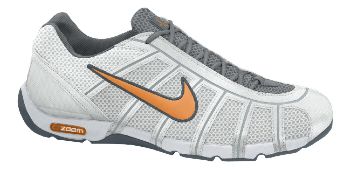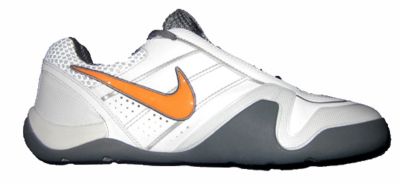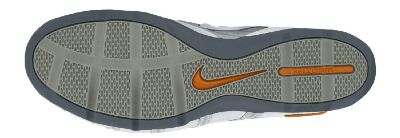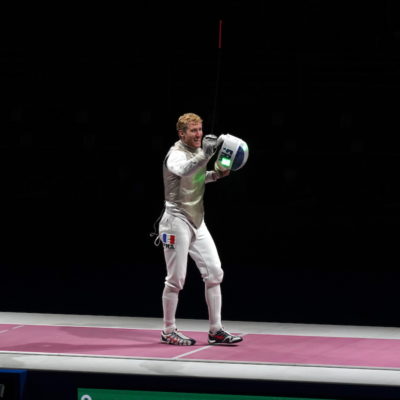 What do you get when you have the Nike design team create a brand new shoe for your sport?
What do you get when you have the Nike design team create a brand new shoe for your sport?
How about something that is 20% lighter than other shoes on the market, engineered for extreme durability, and created with new design elements that make the “mainstream” shoe design teams go “hey, I want to put that in our shoe too!”
Recently, fencing.net had the opportunity to talk with Sean McDowell, the Creative Director for Nike’s Olympic Footwear, about the shoe, the Ballestra, that Nike has been developing for the last 18 months.
As many fencing.net forum posts have shown lately, there is a great deal of interest in what Nike has been up to since they landed the contract for the 2008 (and beyond) Olympics. As part of that contract they need to provide shoes for U.S. Teams, including the US Fencing team. As such, lots of speculation has been floating around. Images from e-bay (like the high top space boot that was listed as a Nike fencing shoe), glimpses of prototype shoes at fencing clubs in the Oregon area, along with samples sent out to Nike sponsored college teams have only increased the interest in what Nike might produce with their initial efforts into the fencing market.
Recently, fencing.net had the opportunity to talk with Sean McDowell, the Creative Director for Nike’s Olympic Footwear, about the shoe, the Ballestra, that Nike has been developing for the last 18 months. Sean has been leading the design and development team and gave us some insight into the development of the shoe, some of the features that the new shoe will have, and Nike’s plans for the immediate future. We also talked with Jeff Pisciotta, the Nike Sport Research Lab biomechanist who headed up the research aspect of development to garner his view of the process.
Both were very open and offered a great deal of information into how Nike has worked to create a fencing shoe that will address the needs of competitive fencers. It was quite interesting to hear how the designers and researchers approached the development of a new product as well as how some of the innovations in the fencing shoe might find their way into other Nike shoes.
In the first part of this article we will summarize some of the salient points from our interviews with Sean and Jeff. In a second part, we will take a closer look at the shoes that Nike has sent for us to review.
Part one: Ballestra–What’s Nike Up To?
What was the design process Nike followed, from inception to final product?
Starting about 18 months ago, Nike had 45 designers focus their efforts on sports that Nike had not developed products for previously. In terms of fencing, the process began by interviewing a variety of fencers. Three designers went out to a local fencing club and spent time talking with top fencers and having them test a variety of fencing shoes currently on the market. They then brought together a focus group of fencers, 16-24 years old, and asked them what they liked about current shoes, what they would improve, and what each fencer thought they needed in competitive shoe. This is typical for Nike when designing shoes—they spend a great deal of time talking to athletes before they invest any significant time designing prototypes. In addition, they did an extensive literature search to see what insights previous sport research studies could provide relative to injuries and biomechanics.

With this background, the design team came up with a few early samples for their first generation prototype. As Sean describes them, “they were not good.” Based on feedback on those shoes they developed a second generation to test that they provided to select U.S. fencers as well as the Chinese National Team. Nike has a commitment to outfit the Chinese Olympic Team, and their 6-8 hour training days provided a great way to conduct extensive wear testing.
In addition, Nike brought fencers into their Sport Research Lab in Beaverton, Oregon, for further studies. This included placing pressure-monitoring inserts into the shoes, comprised of 99 high-resolution sensors, capable of sampling at 250 samples per second. These sensors measured pressure, vertical force, timing, and contact area distribution. Force platforms where used to look at ground reaction forces between the foot and ground during various fencing actions. High-speed video, at up to 500 frames per second, was used, often in conjunction with the force platform and pressure inserts, to collect kinematics and joint angle information. Fencers were asked to go through the various motions associated with fencing, and biomechanical and sensory perception data were collected and analyzed to help inform further changes to the prototypes. Along with testing in the Oregon lab, extensive testing was also done at Nike affiliated research labs in Germany.
All in all, the design team created about 6-7 rounds of prototypes. The final product is still being defined, but the basic features of the shoe are solid now, fencers’ feedback is extremely positive, and only minor changes are expected between now and product launch.
Was there anything about testing or feedback that was surprising?
The first shock to the design team was the amount of pressure generated during impact by a fencer’s lead foot. They knew it wouldn’t be trivial, but were a bit surprised that it was among the highest they’ve seen in sports. At up to 7 times body weight, research showed that it was close to the level of impact measured in basketball when a big man lands after a slam dunk. In addition the extreme angle seen between the foot and ground when landing, up to 45 degrees, was also important to consider when designing the shoe. The cushioning needed to be able to deal with the impact forces at the heel, and provide cushioning in an area of the shoe, the very back of the heel, that was not normally an area of consistent high impact forces in other sports.
The data also showed what every fencer knows, that the shoe on the trailing leg had to deal with, at times, “cheese grater” like wear during a lunge caused by the stress and frictional forces at work on the medial side of the shoe, especially on metal or mesh strips.
The obvious asymmetry of the sport was also a challenge. Although arguments could be made for going with asymmetrical designs, and such a design had proponents within Nike, feedback from fencers supported the idea that, if done right, asymmetrical shoes were not necessary. Given the desire of the Nike design team to make a shoe for the competitive fencer that was durable, lightweight, and affordable, Nike stuck with a symmetrical design to reduce production, distributor, and retail costs.
What materials comprise the upper, midsole, and outsole and how do they contribute to the overall integrity and functionality of the shoe?
Sean is a proponent of the design philosophy that “form follows function.” The three major patterns of fencing—lunge, advance, and retreat—and the forces associated with each must be dealt with and be reflected in the components chosen and integrated in to the design of the shoe. In addition, the perception of the fencer, how the shoe fits and feels, the weight of the shoe, and the feedback it provides to the fencer during a bout, are also important. The basic design challenge then was to include features that would deal with the large impact forces on the heel area and provide sufficient cushioning for the entire foot to help reduce injuries. At the same time, the design had to provide the fencer with a feel for the piste. All of this had to be packaged and delivered in a shoe that would be both affordable and durable.
Upper – For the longest time, the upper was constructed of all leather. Earlier prototypes were considered “sweat boxes”. It took the designers a while to do “what was relatively obvious”—to give the shoe the support that leather offers, but to use a synthetic leather in panels along with mesh to provide a more breathable upper. A significant innovation in the shoe is a series of webbing loops integrated into the upper that creates a type of “internal sandal” with strips that help to cradle the shoe and lock the midfoot down into the midsole platform. The upper uses an essentially seamless construction allowing for a shoe that does not require a sockliner. Nike realized that sockliners add weight to the shoe, and fencers reported that they tend to peel up or get bunched up under the forefoot causing discomfort or the need for replacement. Removing the need for a sockliner has been well received by fencers testing the shoes.

Nike’s research showed that there was a layered wear pattern in certain hot spots, like the medial side of the trailing shoe, that developed over time as different materials were worn through. The Nike solution was to make these areas more abrasion resistant in what they call a type of “staged durability” which includes layers of material including synthetic leather, thermoplastic, and wrap around outsole extensions. Even if the outsole and thermoplastic are worn through, the synthetic leather developed for the Nike fencing shoe is incredibly durable and will continue to resist abrasion. Normal synthetic leather has an expected durability of about 1,000 cycles in an abrasion machine. The synthetic leather developed for this shoe lasts over 30,000 cycles in an abrasion machine. It serves as the last line of defense, once you get through the outsole materials, and other abrasion resistant layers, and is expected to help this shoe be the most durable competitive fencing shoe on the market.
Midsole – The greatest impact forces seen were in the back of the heel area of the leading foot in a lunge—up to 7 times the body weight. As the foot rolls onto the forefoot during the lunge, the forces are much less, but still require a cushioning system to help avoid injury. The shape of the Nike shoe facilitates a kind of “rocking motion” to help spread out the pressure or impact forces, starting with those at the heel, then reducing pressure as the fencer transitions in the lunge to the front of the foot. Overall, materials were selected that offered the best cushioning against impact forces, resisted compaction and loss of cushioning over the life of the shoe, kept the mass of the shoe low, and allowed for the thinnest midsole possible.
The final design reflects this function in a combination of shape, thickness, and materials that comprise the midsole. The rear part of the heel is made of Poron, a type of urethane foam that reduces the jarring impact forces of heel strike, has a high resiliency, and resists compression. The Poron will maintain a large percentage of its cushioning characteristics over the life of the shoe. Under the heel, the shoe stacks Nike Zoom Air on top of the Poron. Zoom Air is a very thin Nike Air midsole with an overlay of fabric in tension that, together with Poron, serves to provide an energy return when compressed. Zoom air will not lose its resiliency and compression characteristics over the life of the shoe. Lastly, the forefoot, that has to deal with the least amount of force, uses Phylon, a lightweight, compression resistant, cushioning material.
Outsole –The overall pattern of the outsole, took a long time to determine. Nike’s research showed that top fencers spend a lot of time up on the forefoot when in preparation, advancing, and retreating. Integrated into the outsole are various flex grooves that extend into the midsole and are scaled depending on shoe size so that they align with the areas of the foot that tend to flex when getting up on the forefoot area or when rolling toward the medial side of the trailing foot during a lunge. These flex grooves also contribute to a more “barefoot” feel without compromising cushioning.

Research also showed that fencers are “ridiculously brutal” on their shoes. The outsole needed to resist abrasion from friction between the shoe and various surfaces, ranging from wood and concrete to aluminum and mesh. To deal with this, the outsole is constructed out of a durable rubber compound, or DRC for short, similar to the compounds used in Nike’s tennis shoes. However, this DRC compound was modified and improved upon to make it even more durable, the most durable currently on any Nike shoe. The material wraps up on the medial side and covers the area of the first phalanx and the tip of the toe. This extension of the outsole works together with the upper to resist wear when the fencer is up on their toes, especially on the trailing foot as it rolls or drags during a lunge.
What is the expected life span of the shoe?
Sean stated that he didn’t have a perfect answer right now since the shoe is so new. In general, he stated that even though it might shock fencing customers, Nike’s philosophy is that a shoe should last three to six months, due to material constraints. This is typical in any competitive sport shoe. He fully expects the shoes to last one season. Although he feels that the materials may last longer, he doesn’t want to over promise.
Mariel Zagunis has had one pair she has worn for intense use over 6 months. She’s tested several pairs, that all seem to be doing fine. The shoes worn by Chinese fencers—who train for six or more hours a day—show little wear, just a little scuffing, and still look good. Most importantly, testing of the Poron and Air sole have shown that they maintain the same cushioning characteristics when measured initially, at three, and at six months. The Phylon in the forefoot area shows the most compression and loss of cushioning over time, but even that is not extensive relative to other shoes.
What colors will be available, when will the shoe be available, and how much will it cost?
Sean stated that they set out to design a shoe for the competitive fencer, and especially the elite athletes they support. Having said this he stated that they also set out to make the lightest shoe, with the best cushioning characteristics, and durability possible. At the same time they wanted to make the shoe affordable given all the functionality built into the shoe. The final design for a size 9 men’s shoe weighs 275 grams—two ounces (20 percent lighter) than other competition shoes on the market. It has better heel cushioning characteristics than any competition shoe, and better forefoot flexibility. In addition, the durability should be excellent.
Current marketing plans will make it available for delivery in August in three colors—metallic platinum/mandarin-flint, white/sport red-light graphite, and white/light blue-dark obsidian. Nike sponsored college and national teams will also have custom color options available to them. Nike is still investigating how best to get the Ballestra into the hands of customers, since the market is quite different from other sports. Given the small size of the market, they will be available on Nike.com, but Nike is doing more research into how best to sell the shoes. The price has not been determined as marketing hasn’t done their final price analysis, but we were told that it would be somewhere between $100.00 and $150.00.
Summary of Features and Benefits for the Ballestra (from Nike Marketing Brief)
- Breathable upper with seamless lining construction offers the best of both a secure and comfortable upper fit.
- No pealing sockliner!
- New flexible, abrasion resistant materials in high-wear areas.
- Highly flexible forefoot and rounded heel engineered to promote nimble advance and retreat.
- Zoom Air and Poron foam for added cushioning in high impact areas.
- Stable base of support in forefoot.
- Outsole designed to maximize traction on competition surfaces.
- Weight = 275 grams (M9): 20% lighter than Adidas Adistar 2000 Fencing shoe.
- Worn by Mariel Zagunis and Margherita Granbassi
How do the shoes measure up when compared to other shoes?
Check back in when we take a closer look at the Nike shoes. We will summarize our view of the shoe in the second part of this article. In addition, If you get a chance, stop by the FNet booth at the Atlanta NAC or the Charlotte Junior Olympics to take a closer look at the Ballestra.
J.L. Larsen was involved in research on the first Air shoes, and worked in the original Nike Sport Research Lab. After leaving industry went into education, teaching high school and middle school. After a brief exile as an administrator, decided to focus on science curriculum development. Fenced a bit in college, off and on since then, renewed interest in the sport and the science behind it when son began fencing. Leads a schizophrenic fencing life with son dedicated to epee and daughter focused on sabre.






4 Comments
Comments are closed.